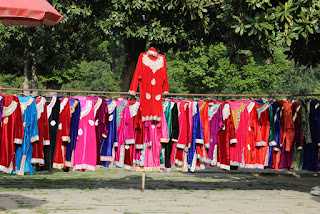REVERSE PSYCHOLOGY
Recently on my visit to Chawri Bazaar in old and real Delhi,
where my ancestors settled, lived and thrived ever since Bahadur Shah Zafar
left Delhi, the paanwala (read panwaari) gave me a good lesson in Reverse
Psychology. Before I give you my story, let me explain what Reverse Psychology
is.
By the way, Chawri Bazaar is close to Chandni Chowk. Metro stops
at both these places. For the uninitiated, the important landmarks of Old Delhi
are, Ajmeri Gate (adjacent to the New Delhi Railway station), Sita Ram Bazaar,
Lal Kuan, Jama Masjid, Fateh Puri, Town Hall, Nai Sarak, Kinari bazaar, etc.
The famous ‘parathe wali gali’ is in a narrow street off Chandni Chowk. Many
important historical landmarks are there; Lal Kila, Jain Temple and its world famous
Birds’ Hospital, Gauri Shankar Mandir, Gurudwara Shish Ganj sahib, Ghalib’s
haveli and many others. This area is famous for many age-old traditions in
eateries. Parathe of parathe wali gali, dahi-bhalla of Central Bank, various
kinds of chaats, paan, kulfi, daulat ki chaat, nagori-sabji-halwa,
poori-berami-sabji and a lot more. Some of the most famous mughlai dishes you
get around Jama Masjid area. And then, there is this kheer, cooked slowly for
hours together on slow wood fire.
If you are not sure of what Reverse Psychology is, let me
explain it for you by the famous example of Shakespeare's characters Romeo and
Juliet. Why Romeo and Juliet fell so passionately in love with each other? Or
for that matter, Majnu-Laila, Heer-Ranjha, Sassi-Punnu, Shirin-Farhad. So many
of our Bollywood movies, the hero and heroine have been victims of this process
of psychology. Anarkali, Ek Duje Ke Liye,
QSQT (Qayamat Se Qamayat Tak), DDLJ (Dilwale Dulhania Le Jayenge) have
exploited it to dramatize a simple story. The list is endless.
If you remember any of the stories, the progress of all stories
is the same. The two lovers meet and take a liking for each other. If the story
ended here, they might have gotten together for life; or be happy for a few
months and then discover that they are very different and don’t really see the
future for themselves. No one would write an epic for them, or make a
blockbuster Bollywood movie.
But, the families play spoilsport; forbid them to see or meet up
with each other. That only fuels their desire to be together. The more family
resists, more intense the attraction gets. Because, something happens that
pushes them towards each other and makes them fight till death for their love. What
is it? The fact that both families ordered the young lovers not to see each other;
and this very reason pulls them towards each other with a magnetic force that
no force on earth can pull them apart.
Whenever somebody forbids us to do something, our sense of
freedom is endangered. Rebellion becomes our natural reaction. This is at its
maximum during our adolescence and young adulthood, the age of risk-taking
behaviour.
This is why using reverse psychology is such an efficient tool
for making others do what you want. It is achieved by telling people to do
opposite of what you actually wish them to do.
The effect of Reverse Psychology on group behaviours has been
exploited extensively by tobacco companies no ends.
All over the world, most of the countries run regular campaigns
for their citizens, especially young, to refrain from smoking. The government
puts many restriction on the sale of tobacco, puts statutory warning on the
cigarette packets, depicts horrible pictures of victims of tobacco related
cancers, and runs advocacy programmes against tobacco use for the school and
college students. Tobacco companies know very well how Reverse Psychology
works. If they have to promote sales of their products, they like to catch the
young population that is their biggest markets. As part of corporate social
responsibility, they undertake, finance, and sponsor such programmes directed
towards school and university students. The apparent tone of the campaign is
‘Say No to Drugs’, ‘Do Not Smoke’, ‘Tobacco Kills’, ‘Smoking Causes Cancer’
etc. Such messages, packaged beautifully and parroted by attractive models,
kindle risk-taking behaviours of the youth. And the tobacco company succeeds in
their ulterior motive of increasing sales of their product, and laughing all
the way to bank.
Back to the story at Chawri Bazaar. I had gone there to buy
‘kulfi’ for a family dinner. At Sita Ram Bazaar (adjacent to Chawri Bazaar),
you get the best kulfi in the town. Over the years (since my childhood), we
have patronized two most famous ones, Duli Chand and Kure Mal, who have been
into the business for generations. The same is true for ‘paan’ also; you get
the best paans in old Delhi. So I decided to buy some paan too for the evening.
Since I was buying quite a few, I had to stay there for some time; while making
paans for me, the paanwala was attending to other customers as well. They were
mostly for packaged water, or buying cigarettes. What surprised me was that the
customers bought one stick only, and none bought the full packet. Each such stick
cost INR 7 or 10. There were posters in the shop warning about the dangers of
smoking. But none was paying any attention to these. When only two of us were
left, I asked him if all the campaign against smoking has dented his sales of
cigarettes. He looked at me with an expression as if I had asked him a stupid
question. He said, “Ever since these campaigns and advertisements against
smoking have begun, the sales of cigarettes have only increased.” He further
said that many years ago, the price of a cigarette packet, and he emphasized
packet once more, was increased by 10 paise only; the result was the sales
decreased by half. Why, because there was no advertisement against smoking then.
Advertisement helps increase the sales, even if it is negative. Badnaam huye to kya hua, naam tou hoga!
No doubt, tobacco is a big killer all over the world. Even if it
does not kill, it impairs our health by affecting practically all the organs
and systems of the body. If our anti-tobacco programmes have to succeed, there
is need to think fresh about how we wish to run our campaign. Time
is Now.

















